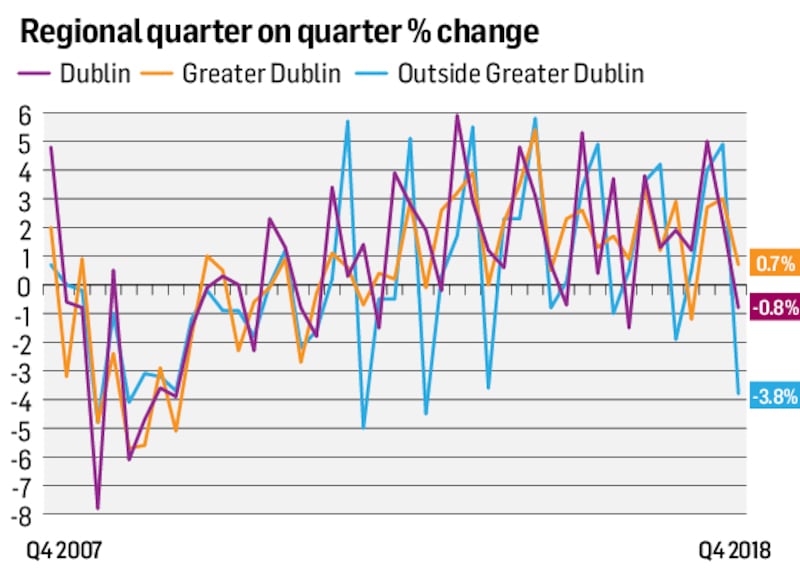The cost of renting a home in Ireland fell marginally in the last three months of 2018 but average monthly rents were still more than €70 higher when compared with the same quarter of the previous year, according to the latest figures from the Residential Tenancies Board (RTB).
Its latest Rent Index covering the three months from October to December suggests that the national average monthly rent was €1,134, a €73 increase on same period in 2017.
However, the figures show that average rents across the country fell slightly between the third and fourth quarter of last year.
In the three months between July and September 2018 rents climbed by 2.3 per cent however they fell 0.3 per cent in the final three months of the year, the first quarter of decline since early 2017.
The average rent in Dublin was put at €1,650, up from €1,530 at the end of 2017. While this is a 7.8 per cent increase in rent in the capital year on year, the average rent was slightly lower in the last three months of the year compared to the €1663 recorded in the previous three months.
Elsewhere in country, the second highest average rents were in Cork City where the cost was put at €1,095 per month followed by Galway City where rents stood were €1,064 . Rents in Limerick City were €929 and rents in Waterford City were €682.
New Rent Pressure Zones
The RTB Rent Index, which is compiled in conjunction with the Economic and Social Research Institute (ESRI), is the authoritative guide to the Irish rental market and is based on actual rents paid on 17,830 tenancies registered with the RTB in the quarter.

Based on the rental data two additional areas have the designation criteria for rent pressure zones - Navan and Limerick City East and as a result increases in these areas will now be limited to a maximum rent increase of 4 per cent per year. These are the first new Rent Pressure Zones to be designated since September 2017.
The director of the RTB Rosalind Carroll said 2018 was "another year with continued pressures in the market and continued rent inflation, with rents now 15 per cent higher nationally than the peak in 2007, and 25% higher in the Dublin market".
However she pointed to “some moderation in the market in the last two quarters” and expressed the hope that “with more supply coming on stream and the RTB getting more regulatory powers that we will see further easing of rent inflation in 2019”
Rents falling
Minister for Housing Eoghan Murphy said it was "encouraging to see rents falling for first time in two years" although he added that there was "no doubt that rents are still too high in many areas".
He said the 0.3 per cent decline in average rents over the last three months of the year were the “first decrease in two years when RPZ’s first came into force. They are working, but I will be bringing further rental reforms to cabinet next week.”
The Simon Communities of Ireland have said figures highlight the difficulties faced by people relying on the private rental sector for secure and affordable accommodation.
"This latest rent index shows that the private rental sector remains beyond the reach of far too many people," said Paul Sheehan of the organisation. He said it was "important to note that these figures don't take into account top-ups and other informal arrangements that people make to remain in the homes they have."
He pointed out “many people have nowhere to go if they cannot afford to rent, and this is one of the key reasons why almost 10,000 people were forced to start 2019 in emergency accommodation.”










